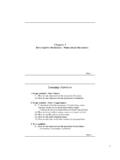Transcription of Descriptive and interpretive approaches to …
1 Chapter 11 Descriptive and interpretiveapproaches to qualitative researchRobert Elliott and Ladislav TimulakQualitative research methods today are a diverse set, encompassing approaches such asempirical phenomenology, grounded theory, ethnography, protocol analysis and dis-course analysis. By one common definition (Polkinghorne, 1983), all these methodsrely on linguistic rather than numerical data, and employ meaning-based rather thanstatistical forms of data analysis. Distinguishing between measuring things with wordsand measuring them in numbers, however, may not be a particularly useful way ofcharacterising different approaches to research. Instead, other distinctive features ofqualitative research may turn out to be of far greater importance (Elliott, 1999): emphasis on understanding phenomena in their own right (rather than from someoutside perspective); open, exploratory research questions (vs.)
2 Closed-ended hypotheses); unlimited, emergent description options (vs. predetermined choices or ratingscales); use of a special strategies for enhancing the credibility of design and analyses(see Elliott, Fischer and Rennie, 1999); and definition of success conditions in terms of discovering something new (vs. confirmingwhat was hypothesised).Space limitations preclude a complete survey of this rapidly growing field of researchmethods. Instead, we will focus on what are today regarded as established, well-usedmethods within the Descriptive interpretive branch of qualitative research. (In parti-cular, we will not cover discourse analysis, , Potter and Wetherell, 1987; Stokoe andWiggins, this volume, or ethnography.
3 These methods came into their own in the1970s and 1980s, and have become mainstream in education, nursing, and increasinglyin psychology, particularly in non-traditional or professional training schools. Becausethere is now an extensive history with these methods, standards of good researchpractice have emerged ( , Elliott et al., 1999). Descriptive interpretive qualitative research methods go by many brand names inwhich various common elements are mixed and matched according to particularresearchers predilections; currently popular variations include grounded 03:36 PM Page 147(Henwood and Pigeon, 1992; Strauss and Corbin, 1998), empirical phenomenology(Giorgi, 1975; Wertz, 1983), hermeneutic- interpretive research (Packer and Addison,1989), interpretative phenomenological analysis (Smith, Jarman, Osborn, 1999), andConsensual Qualitative Research (Hill, Thompson, Williams, 1997).
4 Following Barker,Pistrang and Elliott (2002), we find the emphasis on brand names to be confusing andsomewhat proprietary. Thus, in our treatment here, we take a generic approach thatemphasises common methodological practices rather than relatively minor differ-ences. It is our hope to be able to encourage readers to develop their own individualmix of methods that lend themselves to the topic under investigation and theresearchers preferences and style of collecting and analysing qualitative the approach to qualitative research we present here, we begin with the formu-lation of the research problem, followed by a discussion of issues in qualitative datacollection and sampling. We will then go on to present common strategies of dataanalysis, before concluding by summarising principles of good practice in Descriptive interpretive qualitative research and providing suggestions for further reading the problemPreviously, some qualitative researchers believed that it was better to go into the fieldwithout first reading the available literature.
5 The reason for this position was the beliefthat becoming familiar with previous knowledge would taint the researcher, predis-posing them to impose their preconceptions on the data and raising the danger of notbeing sensitive enough to allow the data speak for themselves in order to reveal essen-tial features of the phenomenon. It is our view that this approach is somewhat one thing, it is now understood that bias is an unavoidable part of the process ofcoming to know something and that knowledge is impossible without some kind ofprevious conceptual structure. Far from removing the researcher s influence on thedata, remaining ignorant of previous work on a phenomenon simply ensures that one swork will be guided by uninformed rather than informed this reason, the formulation of the research problem in qualitative research issimilar in many ways to that in quantitative research.
6 As a consequence, before com-mencing data collection, researchers carefully examine available knowledge and theory,carrying out a thorough literature search that includes up to date information on thetopic of investigation. Strauss and Corbin (1998) refer to this as theoretical sensitivity quoting Pasteur s motto, Discovery favours the prepared mind .An important feature of this initial phase, however, is that the researcher shouldbecome as aware of possible of the nature of their pre-understandings of the phenom-enon, as these are likely to shape the data collection, analysis and interpretation. At thesame time, the researcher should regard their expectations lightly, in a way that is opento unexpected HANDBOOK OF RESEARCH METHODS FOR CLINICAL AND HEALTH 03:36 PM Page 148 The formulation of research problem is guided by the traditional , What do we know about the phenomenon?
7 Why is it important to know more?What has influenced previous research findings (methodology, social context,researcher theory)? What do we want to make clearer by the new study? Note that theproblem formulation itself may not imply a need for a qualitative approach. Therefore,the researcher should not prejudge the question of whether they will use qualitativemethods for the study. Instead, use of a qualitative strategy should emerge as a meansto answer the particular research questions (Elliott, 1995, 2000).The research questions leading to employing qualitative data collection and analysisstrategies are usually open-ended and exploratory in nature. Barker et al.(2002) sug-gest that exploratory questions, suitable as the base for qualitative inquiry are typicallyused when: (a) there is little known in a particular research area; (b) existing research isconfusing, contradictory, or not moving forward; or (c) the topic is highly complex.
8 Asto the aim of exploratory questions, Elliott (2000) sees the following types: Definitional:What is the nature of this phenomenon? What are its definingfeatures? ( , What does it mean for patients with metastatic breast cancer toexperience help in this existential support group treatment?) Descriptive :What kinds or varieties does the phenomenon appear in? What aspectsdoes it have? ( , In what ways do adolescent patients in a cognitive behaviouraltreatment for diabetes self-care change?) interpretive :Why does the phenomenon come about? How does it unfold over time?( , What is the story or sequence of patients improvement in a post-surgerycardiac rehabilitation programme? What changes led to what other changes?)
9 Critical/action:What s wrong (or right) about the phenomenon? How could it bemade better? ( , What complaints do patients have about a specialist sleep disorderclinic?) Deconstruction:What assumptions are made in this research? Whose social orpolitical interests are served by it? ( , What are the cultural and sociopoliticalimplications of the way in which patient outcome has been measured in behav-ioural medicine research, such as focusing on pathology as opposed to health?)Data collectionWhile the formulation of the research problem does not distinguish sharply betweenquantitative and qualitative research traditions,data collection often differs is a difference in the format of the data, but also in the general strategy for obtain-ing the data.
10 As to the format, simply stated, qualitative inquiry looks for verbalaccountsor descriptions in words, or it puts observations into words (occasionally it also usesother forms of description, , drawings by children with leukaemia). Another majordifference is that it uses open-ended questions. However, more importantly, it also usesDESCRIPTIVE AND interpretive approaches TO QUALITATIVE 03:36 PM Page 149an open-ended strategyfor obtaining the data. By open-ended we mean not only thatparticipants are encouraged to elaborate on their accounts, or that observations are notrestricted to certain pre-existing categories. Rather, open-endedness refers to thegeneral strategy of data gathering.







